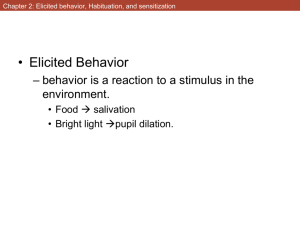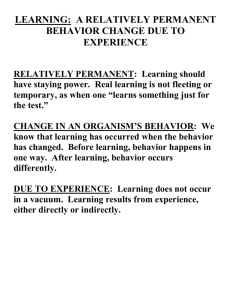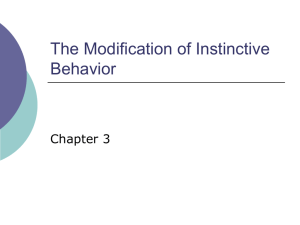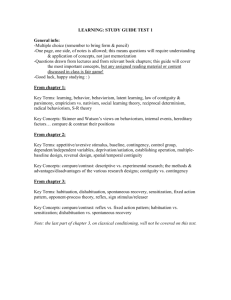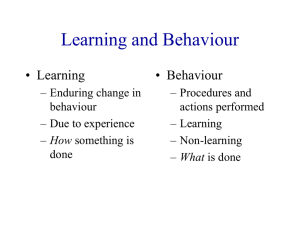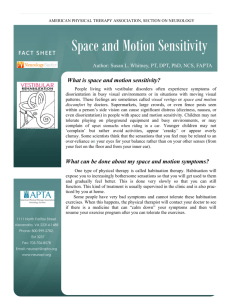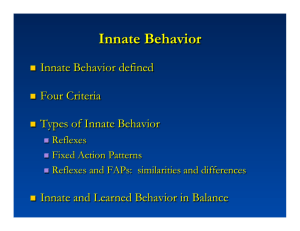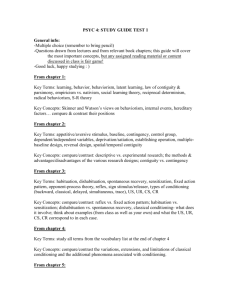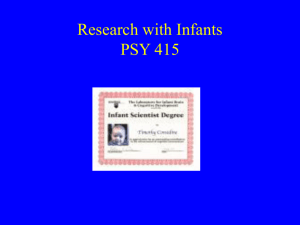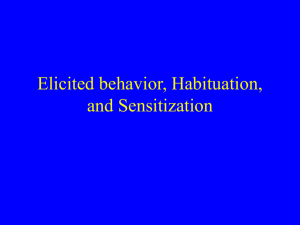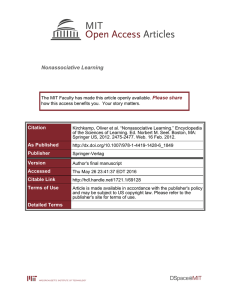Habituation.
advertisement
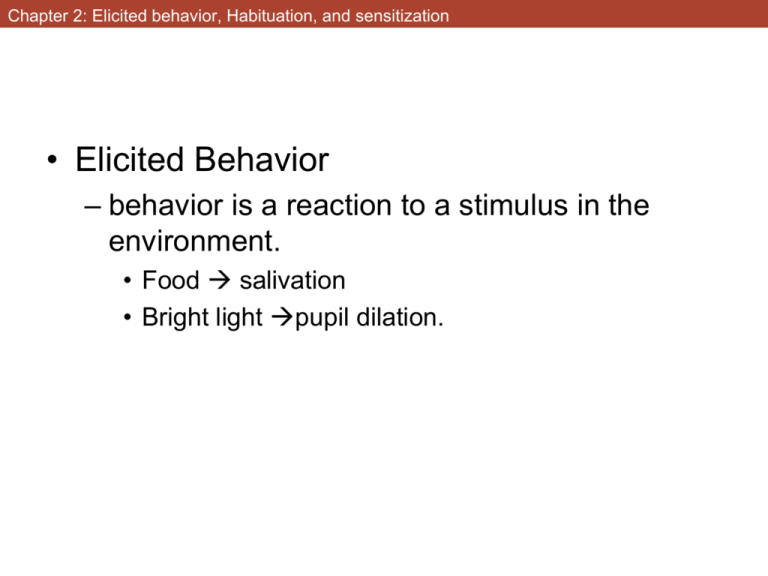
Chapter 2: Elicited behavior, Habituation, and sensitization • Elicited Behavior – behavior is a reaction to a stimulus in the environment. • Food salivation • Bright light pupil dilation. • The simplest form of elicited behavior is the reflex. • Components of a Reflex Arc • All reflex arcs have five essential components – 1. receptor • reacts to a stimulus. – 2. The sensory (afferent) neuron • conducts message to CNS – 3. The integration center • consists of one or more synapses in the CNS. – 4. The motor (efferent) neuron • conducts from CNS to an effector. – 5. The effector, • muscle fibers or glands, – contracts or secretes. • The reflex arc just described = simplest situation. – Often other neural connections are involved. • Notice that the Reflex arc does not require any willful conscious act – Thus - elicited • Reflexes appear to have evolved to protect the well being of the organism. – – – – – – – – withdrawal from pain eyeblink pupillary reflex Sneeze, cough, vomit patellar reflex rooting reflex. salivation release of digestive fluids. • Animals with reflexive tendencies had an advantage • Ethology and Modal Action Patterns – Ethologists study the role of behavior within the context of species-specific behaviors. • This is in contrast to the general processes approach used by most psychologists • Ethologists – behavior is generally instinctive. – often study animals in the wild rather than the laboratory • Consummatory behaviors – behaviors that are crucial for survival. • feeding, courting, reproducing, and care for offspring. – innate, genetically determined survival behaviors. • For Example – Imprinting. • Konrad Lorenz • Why do geese imprint, but other birds/animals (robins) do not? – Precocial vs Altricial? • Ethologists try to find the variables that are responsible for eliciting the behavior. – imprinting = two important factors. • 1. The object must be moving • doesn’t matter if it is living or not – ultra lights • 2. The imprinting must occur within a critical period • (13-16 hours after hatching). • Critical Period for learning some things for humans? – language • Modal Action Patterns. (MAP’s) – modern Ethology abandoned the term instinct • MAPs vs Reflexes – MAPs are • • • • more complex consist of a long series of reflex-like acts more variable, though still stereotypic less likely to be evident at or soon after birth. • In addition, to qualify as a MAP, a behavioral sequence must meet four specific criteria according to Moltz (1963) – 1. Stereotyped • occurs the same way each time – 2. continue to completion once begun • difficult to disrupt – 3. latent period • once completed, some time must pass before behavior appears again – 4. innate • the animal must perform the full integrated behavioral sequence the first time its elicited • • Like Reflexes MAPs are highly adaptive Protection from predators – Cat – arch back, fluff hair, hiss • Protection against the elements – Migration – hibernation • getting food – Pigs rooting – spider webs • courtship and mating – Big Horn Sheep – Ducks • care for young – Birds • • Nests Gathering food – Wasps that capture spiders • Modal Action Patterns are released by a sign stimulus – Sign stimulus • a specific environmental event that triggers an MAP – Female pheromones often trigger mating behavior in males • The sign stimulus works like a key to unlock an innate releasing mechanism – innate releasing mechanism • a neural mechanism that is stimulated by a sign stimulus. • controls the modal action pattern • Examples – Geese with Eggs • Rolling away? • What if it slips on way back? – stereotyped • Larger eggs? – Supernormal stimuli – Birds feeding young • Cowbirds – Herring gull studies • Which beak works best? • Do humans exhibit Modal Action Patterns? – sleep? • • • • Stereotyped? continue to completion once begun? latent period? Innate? – emotions? – sex? • Effects of Repeated Stimulation – Descartes thought that a reflexive response would occur the same way each time it was elicited – However – elicited behavior are not invariant • Habituation. – repeated exposure to a stimulus reduces responding to that stimulus. • Habituation is a very simple form of learning • Very useful tool for understanding animal and infant behavior. • Can you distinguish between “ba” and “pa” – Infants? – Used suck rate as response • Pacifier with an embedded switch • As simple as habituation is, it can be used to tell us a lot about a nonverbal organism • Other race effect – Caucasian infants (3.5 months old) – Group 1 (Caucasian faces) • shown a Caucasian face until habituated – Group2 (Asian faces) • Shown an Asian face until habituated – Test • Both groups shown novel faces – New Caucasian face for group 1 – New Asian face for group 2 Other-race effect in Caucasian infants • HOWEVER, • Repetitive stimulation does not always cause habituation. – sometimes you get sensitization. • My father and motorcycle – emotional response • flee – do not habituate – likely to be more responsive to other stimuli. • tap on the shoulder • drop a wrench. • My dog and car AC • Davis (1974) – sensitization and habituation to the same stimulus. – 110 db noise = loud. • Gp1 = rats housed in a quiet chamber = 60 db • Gp 2 = rats housed in a loud chamber = 80 db • One of the groups decreased their startle response to the 110 db noise after repeated presentations. • The other group increased their startle response to the 110 db noise after repeated presentations. – Which group is which? – What phenomenon does each group demonstrate? • What determines whether we get habituation or sensitization? – Dual process theory • Two simultaneous processes – S-R system • Reflex arc – State system • Involves additional parts of the nervous system that regulate levels of arousal • The S-R system and State system are additive – but in opposite directions – The more active system will determine whether habituation or sensitization is displayed • Example – Checkerboard study in book. – Infants shown checkerboards • 4x4 • 12 x 12 • Habituation versus Sensory Adaptation and Response Fatigue • Sensory Adaptation – Bright light – blinded – Loud noise – can’t hear • Response Fatigue – Too tired to move • Characteristics of Habituation • Habituation is response specific – Some parts of responding may habituate – but others continue to operate. • Announcement while taking a test – Look up » orienting response » quickly habituates – You will likely still be listening however = other response » Listening not habituated • Habituation is stimulus specific – Stop responding to one thing, but if there is a change in the stimulus the habituation goes away. • Dishabituation • Time course for habituation – Short-term = seconds to minutes – Long-term = may persist for many days – Leaton (1976) • Startle response in rats to loud high pitched tone
